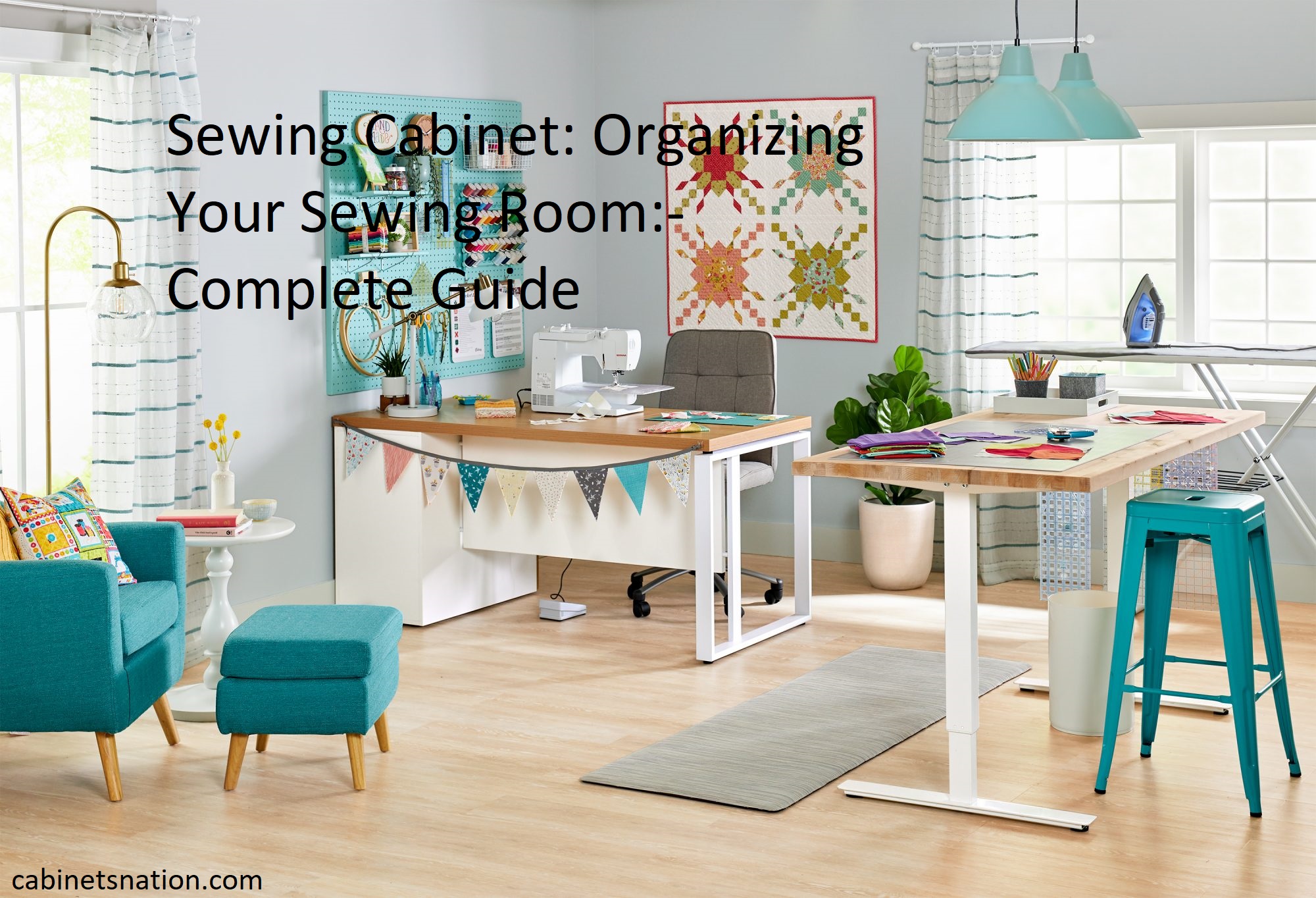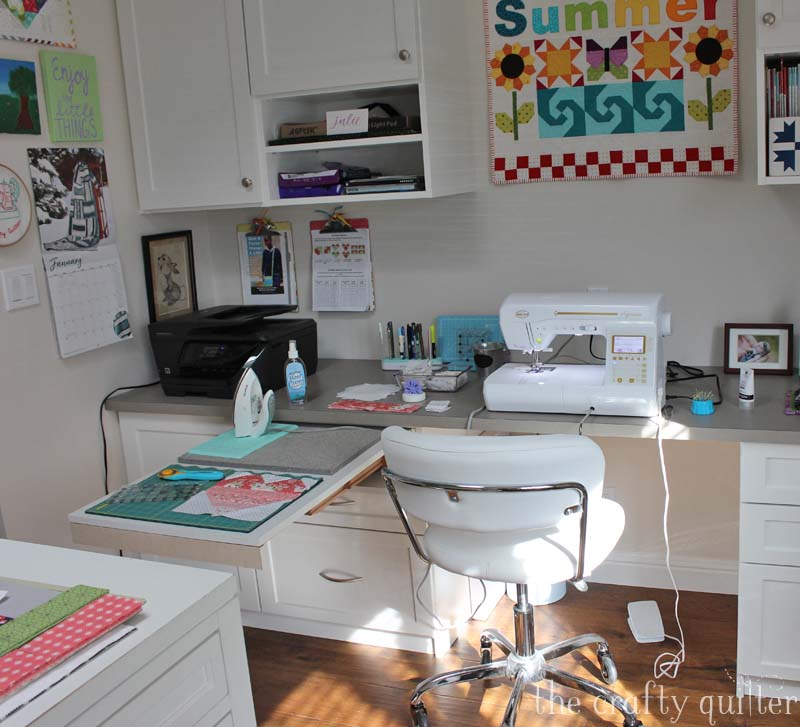Do you dread the sight of your sewing room in disarray? Are you unable to find the tools and supplies you need while sewing? Well, fret no more.
This guide will tell you how to maximize your space with the help of a sewing cabinet, and make your sewing experience smoother! You’ll learn how to store everything in an efficient manner and keep your sewing room tidy.
Ready to get organized? Let’s start!
Getting started sewing can be an exciting and sometimes overwhelming experience. There are a lot of tools and supplies to gather, and even more decisions to make on where to find them. The most important thing is having a space that is both inviting and organized, so that you can easily access the supplies you need when you need them.
This guide will provide helpful tips on organizing your sewing room with a sewing cabinet, including how to choose the right one for you as well as ways to maximize its usefulness once it has been installed. After reading through this guide, you should have a better understanding of how to create an efficient and inspiring workspace in your home.
Factors to Consider when Choosing a Sewing Cabinet
Choosing a sewing cabinet is an important decision as it determines how your sewing room will look tidy, organized, and efficient. Before you purchase a cabinet, there are several factors to consider to ensure the cabinet you select is just right for your needs.
Size: Consider the available area in your sewing room or space. Purchase a cabinet with enough storage capacity so that all of your supplies, fabrics, threads and projects can be stored with ease. Choose a width that neither takes up too much or too little room and measure the depth so everything fits comfortably on shelves within the cabinet.
Adjustability: Look for adjustable shelves that can be customized to meet your needs and accommodate larger items like fabric bolt holders or thread racks without having to buy additional furniture or shelving units. Most cabinets will have at least one adjustable shelf but if you need more flexibility then go for a cabinet with more than one adjustable shelf.
Material: The material of the sewing cabinet should match any other furnishings in the same room so look for cabinets made of wood or metal, both of which have their own advantages in terms of quality and appearance. Wood looks good but may not be as durable as metal furniture whereas metal is more durable yet not necessarily visually pleasing depending on the design finish it has been given.
Style & Color: Do you prefer contemporary styles or something classical? Different manufacturers may offer different styles which often come in different colors too – do some research into what matches well with your current decor so everything looks harmonious together! Keeping in mind that brighter colors also tend to brighten up a room while darker shades make it feel cozier, choose something that will best suit how you want it to reflect against greeneries!
Sewing Space
No matter what size your sewing space is, it’s important to be organized and make it an inviting place for making projects. When planning out a sewing space, you need to think about how to utilize the space in the most efficient manner.
If you have a lot of materials, a good way to keep everything in order is by getting organized with a multi-level cabinet. It can be purchased or easily built with supplies from your local hardware store and will provide easy access storage for tools, fabrics and other materials. You can even add cubbies, racking and drawers to fit your specific needs.
Look around the room you plan to use as your work area and decide what type of organization works best. A great way to maximize storage while taking up minimal floor space is utilizing wall storage units. Shelf brackets are an inexpensive and easy way to mount shelves that you can use for fabric or thread spools or pretty baskets and boxes for fabric scraps or notions and trim -all within reach of your chair! If possible try putting in some extra shelving above the tables that you can visually catalogue fabric pieces that are cut out but not yet used in projects.
Think outside of the box when organizing your work area! Consider using different sized containers like mason jars or tackle boxes for keeping things like bobbins, pins, patterns etc., all in one spot that is easily accessible at any time; use larger bins for storing extra bolts of fabric; attach Velcro strips on walls on one side and items like scissors, rotary cutters or tape measures on their other halves – perfect tools at eye level! You may also want to consider labelling drawers either by content (e.g.[ Patterns],[ Notions])or by project ([ Pillows], [ Quilts]).This way all the items related to each project will be easy to locate when working on several different designs at once.
Sewing Machine Size
Choosing the right sewing machine size for your space and needs can be challenging. Do you need a light and compact machine? Or do you need a more powerful, larger model? There are several factors to consider when selecting the best machine size for your projects. Here are some of those considerations:
Space: Gauge how much room you have in your sewing area and select a machine size that will fit comfortably into its allotted area. Consider how much additional storage space you may need to accommodate fabrics, threads, accessories, etc.
Type of Project: Be sure to choose a model that has ample functions so that it can accommodate all of your sewing needs. If you typically sew larger items like bedding or curtains, be sure to pick one with enough power and flexibility to handle larger projects.
Thread Quantity: If you mainly use one spool of thread at a time then pick a single-needle sewing machine. For multiple color projects look into machines with multiple needles or sergers which have four threads or more available at the same time.
Storage Space
When it comes to organizing a sewing room, storage space is essential. You don’t want your fabrics and supplies to get jumbled up and out of reach. To maximize your storage space for craft supplies, look for cabinetry with adjustable shelves and plenty of drawers. A good idea is to select a rolling cabinet with wheels so you can easily move it around the room when needed.
If possible, look for a piece of furniture that includes a flat surface for laying out projects and has built-in hooks for hanging scissors and other tools. Another plus would be incorporating larger cubbies in one or more drawers so you can store spools of threads, balls of yarn and more.
The best types of cabinets generally have drop-down doors with magnets within them to keep all your items secure when not in use. Additionally, consider investing in drawers with dividers to organize smaller pieces like pins or buttons.Labeling the drawers or compartments will make it easier to find everything quickly when needed during projects.
To save up even more space, try using organizers that hang on the wall – these are particularly useful when storing ribbons, fabric swatches or large balls of wool or cotton thread which take up less room than packaging items separately in boxes or on shelves.

Material and Durability
When organizing your sewing room, one of the most important considerations is to choose cabinet drawers that will stand up to the constant use they will get. Oftentimes, it’s not just the weight of stored items, but the inherent nature of any number of different fabrics and threads that are used in a variety of craft projects. This means that certain woods or other materials may be stronger than others.
When selecting cabinets for sewing rooms, consider woods like Baltic birch which is dense yet flexible and resistant to splitting because of its many layers which are then cross-cut. Other strong choices include hard maple and oak. Materials like oak are durable and also break down tannins which can irritate skin when touched directly or when in contact with fabric that rubs against it for long periods of time. You’ll find other choices such as MDF or plywood too if budget is an issue but be aware these types do not hold up as well to regular wear and tear nor wear them easily over time.
Budget
When deciding how much to spend on a sewing cabinet, the most important thing to consider is what features you need it to have. Many options range from basic cabinets with drawers and shelves to models with extra features like integrated cutting surfaces, thread racks, spool caddies, and adjustable height tables.
In addition to knowing what features you want, it’s also a good idea to consider how often you plan on using it. If you’re an occasional sewer who only needs a storage solution for the occasional project or two then a basic cabinet may be enough. However, if you’re a dedicated quilter or sew on a regular basis then investing in a higher quality cabinet with extra features can help make your time at the machine more efficient and enjoyable. In either case, understanding your budget limitations is key so that you don’t wind up spending too much or too little for what you need.
Price tags vary widely depending on size and feature set but in general expect to spend anywhere from $100 – $1,000 for an average sized cabinet.
How to Organize your Sewing Room
Organizing your sewing room is an important step in setting up an efficient and comfortable workspace for your project. Choosing the right furniture and storage solutions ensures that all of your supplies are easily accessible and organized so you can maximize your sewing time. When planning your space, it’s helpful to consider the following:
Size – The size of the room will determine what type of furniture and storage solutions you need. Choose furniture with wheels to make the most of a smaller space, or opt for heavier stationary pieces if you have a larger area to cover.
Location– Depending on factors such as window placement, find the best spot in the room to place furniture and work tables so they are easily accessible while leaving adequate walking space.
Light sources – Sewing areas should be well-lit; take into account how much natural light is available in conjunction with placement of electric lighting fixtures when deciding where furniture should go. Desk lamps are great for close up projects like embroidery or quilting; choose a three point lamp for maximum ventilation over hot machines or for use when pressing seams open on long-lengths of fabric.
Storage Solutions – Invest in quality storage solutions suitable for organizing small parts like bobbins, needles, spools or buttons; add cabinets or bookshelves if needed for yardage rolls and patterns stored upright. Clear plastic storage boxes are perfect for easy identification of remnants that don’t fit in drawers as well as notions like measuring tape, scissors or seam rippers stored upright.
Categorize Sewing Supplies
When organizing your sewing supplies, it is important to sort them into categories to make it easier to find them. You can sort your supplies into the five main categories of thread, fabric, notions, patterns, and tools.
Thread: This category includes all the threads you need for your projects such as all-purpose thread, embroidery thread, constructed fabric thread and knitting yarn. Additionally, you can also store elastic and any appliques that have a rigidity in this category as well.
Fabric: Fabric is one sewing essential that requires careful organization and storage if you are to make the most of the space in your sewing room. Consider storing different fabrics in separate areas by color or material type. If you have bulk fabrics purchased from a store in larger amounts than you need at one time, place these on rolls as they take up less space than folded pieces. You should also ensure that delicate fabrics such as silk and velvet get special treatment so they don’t get crushed with other materials.
Notions: Notions include fasteners like zippers and snaps used for closures on garments or accessories; trims like ribbon or lace; tailoring items like bias tape; buttons; buckles; patches; hooks & eyes; fusibles (for no-sew projects); fabric glue; pins & needles; rickrack & spool tape etc.
Patterns: It’s important to know exactly where your patterns are kept so that when inspiration strikes and you’re ready to start a new project you can find them quickly and easily. To keep them organized consider sorting them by type of pattern such as skirts vs dresses or blouses vs jackets etc. If a pattern contains individual pieces for each garment part these should be packed separately in an envelope preferably inside the sleeve with the instructions or taped directly onto the piece of paper if they’re thick enough not to tear easily during handling.
Tools: This category includes all your scissors (paper and fabric), cutting mats & rulers, marking tools including tailor’s chalk & tracing paper plus measuring tapes etc. Ideally keep specific scissors (especially shears) devoted exclusively to fabric cutting only – this will help maintain their longevity! It’s also important to regularly sharpen dull blades with a special sharpener dedicated exclusively for this purpose so ensure this is stored close by too!
Storage Solutions for Sewing Supplies
When it comes to organizing your sewing supplies and creating a place that you can use efficiently, storage solutions are key. Whether you are just starting out or already have an extensive sewing cabinet, the right organization and storage system can make all the difference. There are many different methods to choose from when it comes to storing your supplies — from traditional drawers, shelves and pegboards to modern solutions like rolling carts and wall-mounted racks. It all depends on your needs, budget and preferences.
Traditional storage systems often include drawers that can be used for storing cloth in various shapes, sizes and colors along with small rulers, chalk lines and pins. Shelves make excellent solutions for holding spools of thread or large bobbins as well as containers of bias binding or prefold fabric pieces. Pegboards can also be added for hanging fabric scissors, seam rippers and other tools meant for quick access.
Modern storage solutions roll to wherever you need them most with lightweight rolling carts making fabric transporting a breeze. Wall-mounted racks version provide additional space above your room’s surface that’s perfect for smaller items like buttons or trim bits while baskets offer both decorative style as well as secure places to store rolled notions like elastic thread and bias tape.
No matter what type of supplies you carry in your sewing room, with a little bit of creativity there is always good way to store it neatly out of sight!
Layout and Placement of Sewing Cabinet
Before you begin heading out to the store to purchase your sewing cabinet, take a few moments to map out where it will fit in your sewing room. Measure the area carefully, as well as any obstacles that may be in the way. Consider factors such as how much light the spot receives and whether it will be close enough to an electrical outlet for your equipment.
Once you have determined an ideal place for the cabinet, decide on a layout that works with your space. Ideally, you should leave yourself with enough working space while still allowing easy access to all of your tools and fabrics. Sewing cabinets come in a wide variety of sizes and styles—from countertop models to full-sized armoires—so be sure to pick one that best suits you and fits into your chosen area properly.
Tips for Efficient Use of Sewing Cabinet
Sewing cabinets are great for organizing sewing implements, protecting fabrics, and generally keeping a workspace tidy. Here are some tips on how to make the most of them in your sewing room:
- Arrange items by use. Group related items together or use drawer dividers to create sections for easy access.
- Hang lightweight material from the cabinet doors she said. Strong magnets or self-adhesive hooks can help keep materials within reach and off of your work surface.
- Store bulky items like quilt batting, fabric rolls or embroidery hoops under the work surface when not in use, or stack tall rolled fabric on top shelves.
- Use garment shelves with removable pegs to hang extensions of fabric while you sew so they stay out of your way.
- Place a trash can on top shelves which are accessible while working, but out of sight when not in use. You’ll have a convenient spot for scraps near your sewing machine.
- Designate one small drawer or basket for supplies that need quick access, such as scissors, tape measurements and pins. This ensures that you’re always starting with a clean space every time you sew without leaping around looking for supplies.
Cleaning and Maintenance of Sewing Cabinet
To keep your sewing cabinet in good condition and ensure it lasts for many years, regular cleaning and maintenance is important. Your sewing cabinet may need dusting, polishing or other specific measures, depending on the type of material it is made from. As a general rule, avoid using harsh chemicals on the surface of your furniture; instead use a soft cloth with warm water and mild dish soap.
Once cleaned, you should regularly inspect the hinges, drawers and handles for sharp edges or signs of wear to ensure everything is still in good condition. Use appropriate lubricants to make sure all parts are working smoothly and don’t forget to check that your tools are organized properly and that they fit comfortably within their compartments.
Additionally, every one to two years you should apply a coat of wax across the entire surface area of the cabinet while taking extra care on surfaces where heavy usage is expected. Be sure to let the wax layer dry completely before closing any drawers or cupboards. This will help protect the finish from wear over time and make it easier to clean when necessary. With regular maintenance your sewing cabinet should remain in perfect working condition for many years to come!
Conclusion
In conclusion, organizing your home sewing room is an important part of keeping your hobby going smoothly. With the right tools and techniques, you can make your home sewing room an efficient and effective workspace. Taking time to measure, plan, purchase materials and accessories, set up a workspace that works best for you as well as practice proper storage techniques can help you save time in the long run.
Organizing your sewing room should be an enjoyable process that helps you to produce quality projects in a timely manner. Whether you choose the minimalist approach or a more elaborate setup, having what you need (and only what you need) at hand will help make each project more enjoyable without sacrificing quality or efficiency. Finally, don’t forget to take pride in your clean and tidy home sewing space– it reflects well on the skill of the maker!
FAQ’s
What is the best way to organize a sewing room?
The best way to organize a sewing room is to divide it into zones for different activities, such as fabric storage, cutting, sewing, and ironing, and to store items according to type and frequency of use. Eliminate clutter and keep items organized with labeled containers, trays, bins, and shelves. Make sure the space is well-lighted and use furniture and organizational accessories specifically designed for sewing rooms.
How do I organize my fabric in my sewing room?
Organizing your fabric in your sewing room can be done using some storage containers, shelves, and bins. You may also choose to hang fabrics on a rack or wall, or by color or fabric weight.
How do I organize my small sewing room?
Organizing a small sewing room can be a challenge, but can be done with a few simple steps. Start by decluttering the space, getting rid of any items that are no longer needed. Next, make sure all materials, tools, and fabrics are properly stored and labeled. Lastly, create systems to easily access items, such as baskets, dividers, and wall storage.
How do I organize my sewing stuff?
The best way to organize your sewing stuff is by creating a designated space for all of your supplies and tools. This space should include shelves, baskets, bins, and drawers for easy sorting and access. Additionally, labeling your organizing bins and drawers can help you stay organized.
What should a sewing room have?
A sewing room should have a work surface such as a table, a comfortable chair, a sewing machine and other tools such as cutting tools, scissors, rulers and thread, various fabrics, notions and patterns.
How do I organize my small room with too much stuff?
To organize a small room with too much stuff, sort items into categories, decide what can be discarded or donated, make use of vertical storage, and utilize multipurpose furniture.
How do you store sewing space?
You can store sewing space by using storage containers and baskets to keep small items such as buttons and spools, using wall shelves to store fabric, using hanging shelves and racks to store thread and other items, and using storage drawers and cupboards to store bigger items like sewing machines and cutting tables.
What not to do in a sewing room?
Do not leave threads, pins, or unfinished projects lying around the sewing room; they can be a safety hazard. Do not leave scissors or other sharp objects that could cause injury. Do not overcrowd the sewing room with too much furniture or clutter; this can lead to accidental damage or mess. Do not leave fabrics, tools, or supplies in direct sunlight or in excessively warm or cold temperatures; this can damage them. Finally, do not leave open food in the sewing room as it can attract pests.
What color walls look best in a sewing room?
Light colors such as white, light beige, pale pink, lavender, or light blue walls look best in a sewing room to create a bright and cheerful atmosphere.
What is the most important sewing rule?
Always start with a thread and needle that are suitable for the fabric and sewing project.
See more-
- Best outdoor storage cabinet 2023
- Best under cabinet lighting battery 2023
- Best cabinet liners 2023
- Best file cabinet for home office 2023
- Best cabinet doors 2023


